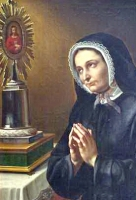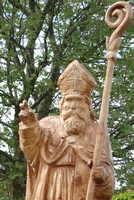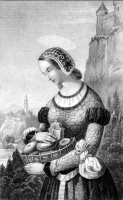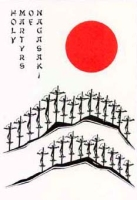St. Louis Ibachi
Feastday: February 5
Death: 1597
Martyr of Japan. A twelve year-old who served the Franciscan mission, Louis was crucified at Nagasaki, Japan, with twenty-five companions. He was canonized in 1867.
St. Leo Karasuma
Feastday: February 5
Death: 1597
Martyr of Japan and a Korean Franciscan tertiary. He was martyred in Nagasaki, Japan, receiving canonization in 1862.
St. Abraham
Feastday: February 5
Death: 345
A bishop of Arbela in Assyria who suffered martyrdom during the persecutions conducted by King Shapur II of Persia. He is recorded as being executed at a site called Telman.
St. Philip of Jesus
Feastday: February 5
Patron: of Mexico City
Birth: 1572
Death: 1597
Franciscan martyr in Japan. A Spaniard born in Mexico City, he entered the Franciscans at Puebla but then departed the order in 1589 to journey to the Philippines as a trader. In 1590, he repented and returned to the Franciscan fold. His superiors commanded him to sail back to Mexico to be ordained a priest and, while on the way, his ship was caught in a storm and driven into the waters of Japan. Landing in 1596, he was soon arrested and, with St. Peter Baptist, was put to death by crucifixion at Nagasaki. He was canonized in 1862.
For the 1949 Mexican film, see Philip of Jesus (film). For other people with similar names, see Philip (name).
Philip of Jesus (Spanish: Felipe de Jesús) was a Novohispanic Catholic missionary who became one of the Twenty-six Martyrs of Japan, the first Mexican saint and patron saint of Mexico City.[1]
Philip was born in Mexico City in 1572. Though unusually frivolous as a boy, he joined the Reformed Franciscans of the Province of St. Didacus, founded in Mexico by Peter Baptista, with whom he suffered martyrdom later. After some months in the Order, Philip grew tired of religious life, left the Franciscans in 1589, took up a mercantile career, and went to the Philippines, another Spanish colony, where he led a life of pleasure. Later he desired to re-enter the Franciscans and was again admitted at Manila in 1590.[2]
After some years it was determined that he was ready for ordination and sent to Mexico for this, since the episcopal see of Manila was vacant at that time, and thus no bishop was available locally to ordain him. He sailed on the San Felipe on 12 July 1596, but a storm drove the vessel upon the coast of Japan. The governor of the province confiscated the ship and imprisoned its crew and passengers, among whom were another Franciscan friar, Juan de Zamorra, as well as three other friars, two Augustinians and a Dominican. The discovery of soldiers, cannon and ammunition on the ship led to the suspicion that it was intended for the conquest of Japan, and that the missionaries were merely to prepare the way for the soldiers. This was also said, falsely and unwarrantably, by one of the crew, and it enraged the Japanese Taikō, Toyotomi Hideyoshi, generally called Taicosama by Europeans. In consequence, he commanded on December 8, 1596, the arrest of the Franciscans in the friary at Miako, now Kyoto, whither Philip had gone.[2]
The friars were all kept prisoners in the friary until December 30, when they were transferred to the city prison. There were six Franciscan friars, seventeen Japanese Franciscan tertiaries and the Japanese Jesuit Paul Miki, with his two native servants. The ears of the prisoners were cropped on January 3, 1597, and they were paraded through the streets of Kyoto; on January 21 they were taken to Osaka, and thence to Nagasaki, which they reached on February 5, 1597. They were taken to a mountain near Nagasaki city, "Mount of the Martyrs", bound upon crosses, after which they were pierced with spears.
Philip was beatified in 1627 by Urban VIII, and, with his companions, canonized 8 June, 1862, by Pius IX. He is the patron saint of the city of Mexico.
In 1949 a Mexican film Philip of Jesus portrayed his life and death. It was directed by Julio Bracho with the actor Ernesto Alonso playing Philip.
St. Gonsalo Garcia
Feastday: February 5
Patron: of the Roman Catholic Archdiocese of Bombay
Birth: 1556
Death: 1597
Saint Gonsalo Garcia (1556-1597) is a Roman Catholic saint from India. Born in the western coastal town of Vasai, an exurb of the city of Bombay, he preached from the Bassein fort during the time the town was under Portuguese colonial rule. The feast of St. Garcia has traditionally been held on the first Sunday nearest to the neap tide following Christmas in Vasai.
Gonsalo Garcia was born Gundi Slavus Garcia-- to a Portuguese father and a Canarese (resident of the Konkan coast) mother in Bassein, on February 5, 1557. He was the right hand of father St. Peter Baptist Superior of Franciscan mission in Japan. He was tutored by Fr. Sebastian Gonçalves, a Jesuit priest working in Vasai, in the college near Bassein fort. Garcia studied under the tutelage of the Jesuits for eight years from 1564 to 1572. Then, at the age of fifteen, Fr. Sebastian took Garcia to Japan. He soon managed to learn the language and since was seen as an affable person; he soon became popular in the local community as a catechist. He resigned and left to Alcao to set up trade. His business prospered and branches were opened in different locales in Southeast Asia.
Gonsalo's long cherished dream to be a Jesuit did not materialise and moved on to Manila in the Philippines as a lay missionary. In the Philippines, he was influenced by a Franciscan priest, Fr. Peter Baptista and soon joined the Seraphic Order as a lay brother. After working with the leprosy patients there he was formally ordained as a Franciscan as the Friars Minor at Manila.
On May 26, 1592, the Spanish governor in the Philippines sent Gonsalo on a diplomatic mission back to Japan along with Baptista. After working for four years, the Japanese shogun suspected the missionaries of sedition and were placed under house arrest in their monastery in Miaco (Kyoto) on 8 December 1596. A few days afterwards, when they were singing vespers, they were arrested, manacled and immured.
On January 3, 1597, the left ears of twenty-six confessors among them Garcia, were exscinded; but were then collected in reverence by the local Christians. On February 5, Garcia was crucified on Nagasaki Hills with twenty six of his companions. St. Garcia was the first to be extended on, and nailed to, the cross, which was then erected in the middle of those of his companions. Fr. Gonsalo, the first to arrive, went straight to one of the crosses and asked "Is this mine?". The reply was "It is not". Then he was taken to another cross, where he knelt down and embraced it. The others, one after another, started doing the same. "That was quite a sight, the way Br. Philip was embracing his cross. . . " comments one of the witnesses. [3] Two lances impaled his body through his heart. While being nailed, Garcia sang praises of God, earning him the martyr's title.
In 1627, Garcia and his fellow martyrs were declared as Venerable by Pope Urban VIII. The martyr's feast day occurs on Feb 5th and in 1629, their veneration was permitted throughout the Catholic Church. On June 8, 1862 Garcia was declared a saint by Pope Pius IX. The Gonsalo Garcia Church in Vasai was built in 1942 and renovated in 1957. A weeklong feast is celebrated there in February in his honour. The church is tallest church in Vasai[citation needed]. It was built by Msgr. Louise Caitan D'souza a Goan priest.
For other people named Gonzalo Garcia, see Gonzalo Garcia (disambiguation).
Gonsalo Garcia, O.F.M. (Portuguese: Gonçalo Garcia; 1556 – 5 February 1597),[1] was a lay brother of the Franciscans from Portuguese Bombay and Bassein in early modern India. He died a Christian martyr in the 16th-century Shogunate of Japan, and was canonised a saint along with his companions, the Twenty-six Martyrs of Japan.[1] He was born at Bassein (Vasai), Baçaim in the Indo-Portuguese era, an exurban town of the present-day Greater Bombay metropolis.
Saint Agatha of Sicily
சிசிலியின் புனிதர் அகதா
(St. Agatha of Sicily)
கன்னி மற்றும் மறைசாட்சி:
(Virgin and Martyr)
பிறப்பு: கி.பி. 231
கேட்டனியா அல்லது பலெர்மோ, சிசிலி
(Catania or Palermo, Sicily)
இறப்பு: கி.பி. 251
கேட்டனியா, சிசிலி
(Catania, Sicily)
ஏற்கும் சபை/ சமயம்:
ரோமன் கத்தோலிக்க திருச்சபை
(Roman Catholic Church)
கிழக்கு மரபுவழி திருச்சபை
(Eastern Orthodox Churches)
ஓரியண்ட்டல் மரபுவழி திருச்சபை
(Oriental Orthodoxy)
ஆங்கிலிக்கன் சமூகம்
(Anglican Communion)
நினைவுத் திருவிழா: ஃபெப்ரவரி 5
பாதுகாவல்:
கேட்டனியா (Catania), மோலிஸ் (Molise), மால்ட்டா (Malta), சேன் மரினோ (San Marino), ஸ்பெயின் நாட்டின் செகோவியா பிராந்தியத்திலுள்ள 'ஸமர்ரமல' என்னும் ஊர்ப்பஞ்சாயத்து (Zamarramala, a municipality of the Province of Segovia in Spain), மார்பக புற்று நோயாளிகள் (Breast cancer patients), மறைசாட்சிகள் (Martyrs), செவிலியர் (Wet Nurses), கலிபோர்னியாவின் தென்மேற்கு பிராந்தியத்திலுள்ள "பெல்" என்ற நகரை கண்டுபிடித்தவர்கள் (Bell-Founders), ரொட்டி செய்யும் தொழிலாளி (Bakers), தீ (Fire), பூகம்பம் (Earthquakes), "எட்னா" மலையின் வெடிப்புகள் (Eruptions of Mount Etna).
சர்ச்சைகள் (Controversy):
ரோமப் பேரரசர்களை வணங்க மறுத்தல்
(Rejection to worship Roman Emperors)
கட்டாயப்படுத்தப்பட்ட பாலியல் தொழில்
(Forced prostitution)
பாலியல் வன்கொடுமை, மற்றும் கன்னித்தன்மையை காத்துக்கொள்வதற்கான போர்
(Rape and conflict to maintain virginity)
புனிதர் அகதா, மறைசாட்சியாக மரித்த ஒரு கன்னியரும், கிறிஸ்தவ புனிதருமாவார். ரோமன் கத்தோலிக்க திருச்சபையின் திருப்பலியின்போது, கடவுளை அதிதூய அன்னை, அர்ச்சிஷ்ட்ட கன்னி மரியாளுடன் சேர்ந்து நினைவுகூறப்படும் ஏழு பெண்களில் இவரும் ஒருவர் ஆவார்.
பழங்கால கிறிஸ்தவ புராணத்தில், மிகவும் உயர்வாக போற்றப்படும் கன்னியராக மறைசாட்சியாக மரித்த பெண்களுள் புனிதர் அகதாவும் ஒருவர் ஆவார். கி.பி. 249ம் ஆண்டு முதல் 253ம் ஆண்டு வரையான காலகட்டத்தில், ரோமப் பேரரசை ஆண்ட பேரரசன் "டேசியஸ்" (Full Name - Gaius Messius Quintus Trajanus Decius) என்பவன் கிறிஸ்தவர்களுக்கெதிரான துன்புறுத்தல் மற்றும் சித்திரவதைகளை ஆரம்பித்து வைத்த முதல் பேரரசன் ஆவான். இவனது காலத்திலேயே புனிதர் அகதா, சிசிலியில் உள்ள “கேட்டனியா” (Catania) என்னும் இடத்தில் வைத்து, தமது மிக உறுதியான கிறிஸ்தவ விசுவாசத்திற்காக கொடூரமான முறையில் வதைக்கப்பட்டு கொல்லப்பட்டார்.
வசதிவாய்ப்புகளுள்ள குடும்பமொன்றில் பிறந்த அகதா, ஆன்மீகத்தில் ஈடுபாடு மிகக்கொண்டிருந்தார். தமது வாழ்வின் ஒவ்வொரு தருணங்களும் இறைவனால் தீர்மானிக்கப்பட்டவை என்ற தீவிர விசுவாசம் கொண்டிருந்தார். "ஜாகொபஸ் டி வொராஜின்" (Jacobus de Voragine) என்ற கிறிஸ்தவ சரித்திர ஆசிரியரின் (Legenda Aurea of 1288 AD) எனும் இலக்கியத்தின்படி, அகதா தமது கன்னிமையை இறைவனுக்கே அர்ப்பணித்தார். இவருக்கு பதினைந்து வயதானபோது, இவர்மீது மோகம் கொண்ட ரோமன் நிர்வாக அலுவலரான (Roman prefect) "குயின்ஷியானஸ்" (Quintianus) என்பவனை தீர்க்கமாக நிராகரித்தார். ஆத்திரம் கொண்ட குயின்ஷியானஸ், இவரை இவரது கிறிஸ்தவ விசுவாசத்துக்காக துன்புறுத்தினான். பின்னர், "அப்ரோடிசியா" (Aphrodisia) என்ற விபச்சார விடுதி நடத்துபவனிடம் அனுப்பினான்.
அவரை எளிதில் கையாள முடியாது என்பதை கண்டுகொண்ட குயின்ஷியானஸ், அகதாவை பயமுறுத்தினான். அவருடன் வாதிட்டான். இறுதியில் அவரை சிறையில் அடைத்தான். சிறையில் எண்ணற்ற சித்திரவதைகளுக்கு ஆளான அகதாவின் மார்பகங்களை குறடு போன்ற இடுக்கியால் அறுத்தனர். மேற்கொண்டும் அவனுக்கு மசியாத அகதா அவனுடன் வியக்கத்தக்க வகையில் வாதிட்டு தமது மனோபலம் மற்றும் உறுதியான பக்தியைக் காண்பித்தார்.
இறுதியில், அகதாவை கூறிய மரக்குச்சுகளினால் தீயிட்டு எரித்துக் கொள்ள தீர்ப்பிடப்பட்டது. ஆனால் அவரது விதி, அவரை ஒரு பூகம்பம் மூலம் இரட்சித்தது. மீண்டும் சிறையிலடைக்கப்பட்ட அகதாவுக்கு அப்போஸ்தலரான புனிதர் பேதுரு (St. Peter the Apostle) காட்சியளித்து அவரது மார்பக மற்றும் உடலிலிருந்த காயங்களை ஆற்றினார். புனிதர் அகதா சிறையிலேயே மரித்துப் போனார். "கட்டானியா" பேராலயம் (Catania Cathedral) இவர் பெயரில் அர்ப்பணிக்கப்பட்டதாகும்.
Also known as
• Agatha of Catania
• Agatha of Palermo
• Águeda...
Profile
We have little reliable information about this martyr, who has been honoured since ancient times, and whose name is included in the canon of the Mass. Young, beautiful and rich, Agatha lived a life consecrated to God. When Decius announced the edicts against Christians, the magistrate Quinctianus tried to profit by Agatha's sanctity; he planned to blackmail her into sex in exchange for not charging her. Handed over to a brothel, she refused to accept customers. After rejecting Quinctianus's advances, she was beaten, imprisoned, tortured, her breasts were crushed and cut off. She told the judge, "Cruel man, have you forgotten your mother and the breast that nourished you, that you dare to mutilate me this way?" One version has it that Saint Peter healed her. She was then imprisoned again, then rolled on live coals; when she was near death, an earthquake stuck. In the destruction that followed, a friend of the magistrate was crushed, and the magistrate fled. Agatha thanked God for an end to her pain, and died.
Legend says that carrying her veil, taken from her tomb in Catania, in procession has averted eruptions of Mount Etna. Her intercession is reported to have saved Malta from Turkish invasion in 1551.
Born
in prison at Catania or Palermo, Sicily (sources vary)
Died
martyred c.250 at Catania, Sicily by being rolled on coals
Patronage
• against breast cancer
• against breast disease
• against earthquakes
• against eruptions of Mount Etna
• against fire
• against natural disasters
• against sterility
• against volcanic eruptions
• bell-founders
• fire prevention
• jewelers
• martyrs
• nurses
• rape victims
• single laywomen
• torture victims
• wet-nurses
• Malta
• San Marino
• 64 cities in Belgium, Canada, France, Germany, Italy, Spain and the Netherlands
Blessed Elisabetta Canori Mora
Profile
Born to a wealthy Italian noble family, the daughter of Tommaso and Teresa Primoli. She married Cristoforo Mora on 10 January 1796. Cristoforo, a lawyer, was jealous, controlling, and became suspicious of Elisabetta's family ties; he finally became resentful, abusive, then cold and indifferent to her. Along the way they had four daughters, two of whom died in infancy. Cristoforo took up with another woman, spent the family funds on her, and finally deserted Elisabetta and the girls, leaving them in poverty. Elisabetta's health broke, she became very ill, and was finally compelled to sell inherited jewelry and her wedding dress to pay her bills. She dedicated herself to caring for her children, to prayer, and to a quiet ministry of caring for the sick and the poor, especially poor families. Trinitarian tertiary. Her reputation for holiness spread, as did a reputation for mystic experiences and miracles. Her prayers certainly achieved one amazing result - after her death, Cristoforo changed his life, joined in the Franciscans, and became a priest in Sezze, Italy.
Born
21 November 1774 in Rome, Italy
Died
• the night of 5 February 1825 in Rome, Italy
• buried at the Church of San Carlino alle Quattro Fontane, Rome
Beatified
24 April 1994 by Pope John Paul II
Saint Adelaide of Guelders
Also known as
• Adelaide of Vilich
• Adelaide of Bellich
• Alice, Adelheid, Adalheide
Profile
Daughter of Megingoz (Megengose), Count of Guelders. Joined the Ursuline convent at Cologne, Germany. Benedictine nun. Abbess of Villich, Germany. Abbess of Our Lady of the Capitol at Cologne. Both houses had been founded by her father. She insisted that the sisters in her houses study Latin so they would better understand the Mass. Noted for her charity to the poor. Counselor to the archbishop of Cologne.
Born
c.960 in Geldern, North Rhine-Westphalia, Germany
Died
• 5 February 1015 at Our Lady of the Capitol convent at Cologne, North Rhine-Westphalia, Germany of natural causes
• buried in Villich, Germany
Beatified
27 January 1966 by Pope Paul VI (cultus confirmation)
Patronage
against eye diseases
Saint Avitus of Vienne
Also known as
Alcimus Ecdicius
Profile
Son of Saint Isychius. Brother of Saint Apollinaris of Valence. Bishop of Vienne, France, succeeding his father. Fought Arianism, ransomed captives, and supported papal authority as the mainstay of religious unity. Brought King Saint Sigismund of Burgundy, and was well thought of personally not only by the Christians in his diocese but also the pagan Franks and Arian Burgundians. Presided over the Council of Epaon in 517. He wrote a long, elegant narrative poem describing original sin, expulsion from paradise, the Flood, and crossing of the Red Sea; Milton made use of it when writing Paradise Lost.
Born
c.451 in Auvergne, Vienne, Gaul (in modern France)
Died
• c.525 of natural causes
• relics at Vienne, France
Saint Bertulph of Renty
Also known as
Berton, Bertou, Bertoul, Bertulf, Bertulphe, Bertulphus
Profile
Convert as a young man in Flanders, Belgium. Managed a farm in Renty, France for Count Wambert for several years. Pilgrim to Rome, Italy. Parish priest in Renty. Founded and led a monastery nearby until his death.
Born
c.640 in eastern Europe
Died
• c.705 of natural causes
• relics enshrined at Harelbeke, Belgium
• relics interred in an iron chest at Saint Peter's Abbey, Ghent, Belgium
• relics stolen in 939 but located and returned by Count Arnulf of Flanders and Bishop Wigbert of Thérouanne
• relics destroyed by Huguenots in 1578
Patronage
against storms
Saint Genuinus of Sabion
Also known as
Genuino, Ingenium, Ingenuin, Ingenuino, Ingenuinus, Ingwin, Jenewein
Additional Memorial
13 May (translation of relics)
Profile
Bishop of Sabion, a small town of the Italian Tyrol that has since disappeared. Attended the Synod of Marano in 588.
Born
6th century
Died
• c.605 in Sabiona, Italy of natural causes
• relics transferred to the main altar in the cathedral in Bressanone, Italy
Patronage
• mines
• miners
• diocese of Bolzano-Bressanone, Italy
• diocese of Brixen, Italy
Saint Albinus of Brixen
Also known as
• Albinus of Säben-Brixen
• Albinus of Bressanone
• Albuin, Albuino, Albuinus
Profile
Born to the nobility, the son of Blessed Agatha Hildegardis of Carinthia and Count Paul, Margrave of Carinthia. Bishop of Sabion, South Tyrol (in modern Italy) in 975, a see that was moved to Brixen, Italy.
Born
10th century Carinthia, Austria
Died
• 5 February 1005 in Brixen, Italy
• relics transferred to the cathedral in Bressanone, Italy in 1141
Patronage
• Bressanone, Italy
• Brixen, Italy, city of
• Brixen, Italy, diocese of
Saint Calamanda of Calaf
Profile
Young woman martyred in the persecutions of Diocletian. A number of other stories have been attached to her including that she was one of the companions of Saint Ursula or that her father killed her for refusing an arranged marriage, but these are apparently stories in search of a character that were simply stuck on her later.
Born
Calaf or Anoia, Catalonia, Spain
Died
• arms hacked off so that she bled to death in 303 in Calaf, Spain
• buried in the church of San Jaume in Calaf
Canonized
Pope Urban V (cultus confirmation)
Patronage
• against drought
• Calaf, Spain
Saint Agatha Hildegard of Carinthia
Also known as
Liharda
Profile
Lay woman, married to Count Paul of Carinthia (part of modern Austria. He was a jealous man who abused her for years before her prayers and devotion converted him to the faith and changed his ways. Mother of Saint Albinus of Brixen. Widow. Venerated in Carinthia as a model wife.
Born
Austrian
Died
1024 of natural causes
Saint Luca di Demenna
Also known as
Luca d'Armento
Profile
Monk in Sicily. When the Muslim Saracens invaded the region, he moved from house to house to avoid them. Founded the monastery of Saints Elias and Anastasio, Carbone, Italy and served as its first abbot. Luca based his approach to the monastic life on the Greek monks.
Born
10th century Sicily, Italy
Died
• 5 February 995 in the monastery of Saints Elias and Anastasio in Carbone, Italy of natural causes
• buried in the monastery church
Saint Jes¨s Méndez-Montoya
Also known as
Ges¨ Méndez
Additional Memorial
21 May as one of the Martyrs of the Mexican Revolution
Profile
Priest in the diocese of Morelia, Mexico. During the persecutions of the Mexican Revolution, he hid in the villages of the peasants, living with the poorest, teaching catechism. Musician and music teacher. Martyr.
Born
10 June 1880 in Tarímbaro, Michoacán, Mexico
Died
shot three times on 5 February 1928 in Valtierrilla, Guanajuato, Mexico
Canonized
21 May 2000 by Pope John Paul II
Saint Anthony of Athens
Also known as
Antonius
Profile
A slave purchased by a series of Muslims, each of which tried (and failed) to convert him from Christianity. One of them finally falsely denounced him as having converted to Islam and then back to Christianity, which was a capital offense. Martyr.
Born
Athens, Greece
Died
• the executioner tapped him lightly on the neck several times in hopes that Anthony would denounce Christianity; he wouldn't
• beheaded in 1777 in Constantinople
Saint Kichi Franciscus
Also known as
• Caius Francis
• Gaius Francis
Profile
Layman soldier. Convert. Franciscan tertiary. When soldiers came to arrest the Franciscan friars, he insisted he was a Christian, too; they took him, and he shared their fate. Martyr.
Born
Kyoto, Japan
Died
crucified on 5 February 1597 at Nagasaki, Japan
Canonized
8 June 1862 by Pope Pius IX
Saint Dominica of Shapwick
Also known as
Drusus
Profile
Irish princess. Following a pilgrimage to Rome, Italy, she was murdered with her brother, Saint Indract, and six others by heathen Saxon brigands. Because they were on a holy journey, and were killed by non-Christians, contemporaries considered them martyrs. Later legends swell the number of her martyred companions to 100.
Born
Irish
Died
• c.710 at Shapwick, England
• relics at Glastonbury, England
Saint Indract
Profile
Irish prince, noted for gentleness and piety. Following a pilgrimage to Rome, Italy, he was murdered with his sister, Saint Dominica, and six others by heathen Saxon brigands; because they were on a holy journey, and were killed by non-Christians, contemporaries considered them martyrs. Later legends incorrectly make Indract a friend of Saint Patrick, and swell the number of his martyred companions to 100.
Born
Irish
Died
• c.710 at Shapwick, England
• relics at Glastonbury, England
Blessed Françoise Mézière
Additional Memorial
21 January as one of the Blessed Martyrs of Laval
Profile
Lay woman in the diocese of Laval, France. Martyred in the French Revolution.
Born
25 August 1745 in Mézangers, Mayenne, France
Died
5 February 1794 in Laval, Mayenne, France
Beatified
19 June 1955 by Pope Pius XII at Rome, Italy
Saint Gabriel de Duisco
Profile
Convert, brought to the faith by Saint Gundisalvus Garcia. Franciscan tertiary. Catechist. Martyr.
Born
c.1578 at Ise, Japan
Died
crucified on 5 February 1597 at Tateyama (Hill of Wheat), Nagasaki, Japan
Canonized
8 June 1862 by Pope Pius IX
Blessed John Morosini
Profile
Benedictine monk at Cuxá, Catalonian Pyranees. Founded the monastery of San Giorgio Maggiiore in Venice, Italy c.982, and served as its first abbot.
Born
at Venice, Italy
Died
1012 of natural causes
Beatified
never formally beatified, and there is no evidence of popular cultus, but always referred to as beatus
Saint Agricola of Tongres
Also known as
Agricolus, Agricolaus
Additional Memorial
15 May as one of the Bishops of Maastricht
Profile
Bishop of Tongres, Belgium in 384.
Born
4th century Netherlands
Died
• early morning of 18 July 401 of natural causes
• buried in the church of Our Lady in Huy, Belgium
Blessed Primo Andrés Lanas
Also known as
Trinidad
Profile
Monk. Member of the Hospitallers of Saint John of God. Martyred in the Spanish Civil War.
Born
7 February 1877 in Maeztu, Alava, Spain
Died
5 February 1937 in Madrid, Spain
Beatified
13 October 2013 by Pope Francis
Saint Vodoaldus of Soissons
Also known as
Vodale, Voel, Vodalis, Vodalus
Profile
Missionary from the British Isles to France. Hermit beside Saint Mary's convent at Soissons, France. Known as a miracle worker.
Born
Irish or Scottish
Died
725 near Soissons, France of natural causes
Saint Saba the Younger
Profile
Brother of Saint Macarius. Monk. Worked with his brother to spread the monastic life through the Calabria and Lucania regions of Italy during a time when Muslim Saracen invaders were disrupting religious life.
Died
995 in the monastery of San Cesario, Rome, Italy
Saint Modestus of Carinthia
Also known as
Modestus of Salzburg
Profile
Benedictine monk. Spiritual student of Saint Virgilius at Salzburg, Austria. Bishop of Carinthia, Austria, and largely responsible for the region's evangelization.
Died
c.722 of natural causes
Saint Buo of Ireland
Profile
Monk. Missionary to the Norwegians on Iceland and the Faroe Islands.
Born
Irish
Died
c.900 of natural causes
Saint Isidore of Alexandria
Profile
Martyr.
Born
Egyptian
Died
Alexandria, Egypt
Saint Fingen of Metz
Profile
Monk. Abbot. Known for restoring old monasteries.
Born
10th century Ireland
Died
c.1005
Martyrs of Pontus
Profile
An unknown number of Christians who were tortured and martyred in assorted painful ways in the region of Pontus (in modern Turkey) during the persecutions of Maximian.













கருத்துகள் இல்லை:
கருத்துரையிடுக